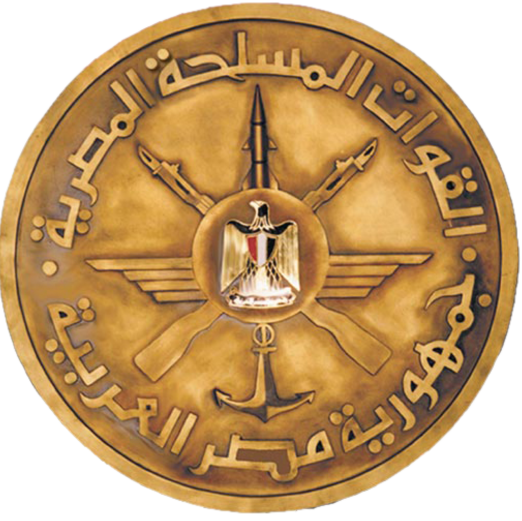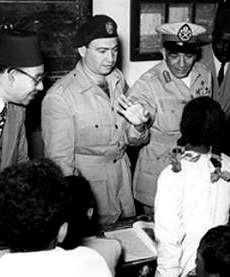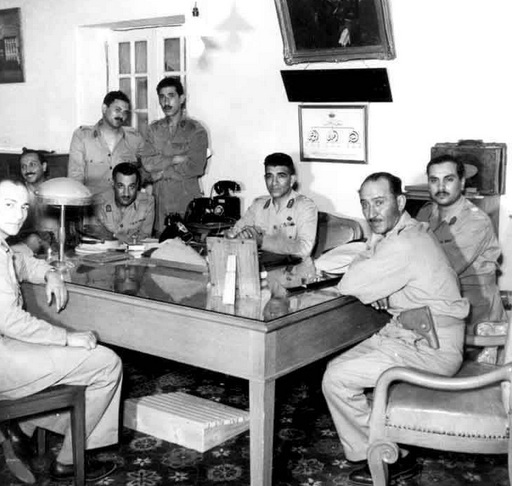|
Mankabad
Manqabad also spelled Mankabad ( ar, منقباد, from ) is a town in Upper Egypt, near the city of Asyut. A military station was located in the town which was referred to as "beyond civilization", being the last vestige of the Nile River Valley before the southern desert. In the 1940s, the station had 3000 officers and soldiers, including a number of whom like Gamal Abdel Nasser, Khaled Mohieddin and Anwar Sadat who would become members of the Free Officers Movement. In 1965, an ancient Copt Copts ( cop, ⲛⲓⲣⲉⲙⲛ̀ⲭⲏⲙⲓ ; ar, الْقِبْط ) are a Christian ethnoreligious group indigenous to North Africa who have primarily inhabited the area of modern Egypt and Sudan since antiquity. Most ethnic Copts are Co ...ic site was accidentally found at Manqabad and major excavations were undertaken there in 1976, 1984, and 1995. Several churches and chapels dating from the 7th to 8th centuries were excavated. Surname Manqabad is also the town of origin of t ... [...More Info...] [...Related Items...] OR: [Wikipedia] [Google] [Baidu] |
Manqabadi
Manqabadi (also spelled Manqbadi, Mankabadi, Mankbadi, among other variations) is an Egyptian surname and is a derivative of the city of Manqabad. It means "from Manqabad." People Notable people with the surname include: * Albert Selim El-Mankabadi, Egyptian rower * Reda R. Mankbadi, professor *Samir Mankabady, lawyerMankabady, Samir. (1986)''The International Maritime Organization.''London: Routledge. See also * Manqabad, a town in Upper Egypt, near the city of Asyut AsyutAlso spelled ''Assiout'' or ''Assiut'' ( ar, أسيوط ' , from ' ) is the capital of the modern Asyut Governorate in Egypt. It was built close to the ancient city of the same name, which is situated nearby. The modern city is located at , ... References {{surname Arabic-language surnames Patronymic surnames ... [...More Info...] [...Related Items...] OR: [Wikipedia] [Google] [Baidu] |
Manqabad
Manqabad also spelled Mankabad ( ar, منقباد, from ) is a town in Upper Egypt, near the city of Asyut. A military station was located in the town which was referred to as "beyond civilization", being the last vestige of the Nile River Valley before the southern desert. In the 1940s, the station had 3000 officers and soldiers, including a number of whom like Gamal Abdel Nasser, Khaled Mohieddin and Anwar Sadat who would become members of the Free Officers Movement. In 1965, an ancient Coptic site was accidentally found at Manqabad and major excavations were undertaken there in 1976, 1984, and 1995. Several churches and chapels dating from the 7th to 8th centuries were excavated. Surname Manqabad is also the town of origin of the Manqabadi Manqabadi (also spelled Manqbadi, Mankabadi, Mankbadi, among other variations) is an Egyptian surname and is a derivative of the city of Manqabad. It means "from Manqabad." People Notable people with the surname include: * Albert Selim El- ... [...More Info...] [...Related Items...] OR: [Wikipedia] [Google] [Baidu] |
Gamal Abdel Nasser
Gamal Abdel Nasser Hussein, . (15 January 1918 – 28 September 1970) was an Egyptian politician who served as the second president of Egypt from 1954 until his death in 1970. Nasser led the Egyptian revolution of 1952 and introduced far-reaching land reforms the following year. Following a 1954 attempt on his life by a Muslim Brotherhood member, he cracked down on the organization, put President Mohamed Naguib under house arrest and assumed executive office. He was formally elected president in June 1956. Nasser's popularity in Egypt and the Arab world skyrocketed after his nationalization of the Suez Canal Company and his political victory in the subsequent Suez Crisis, known in Egypt as the ''Tripartite Aggression''. Calls for pan-Arab unity under his leadership increased, culminating with the formation of the United Arab Republic with Syria from 1958 to 1961. In 1962, Nasser began a series of major socialist measures and modernization reforms in Egypt. Despite setba ... [...More Info...] [...Related Items...] OR: [Wikipedia] [Google] [Baidu] |
Upper Egypt
Upper Egypt ( ar, صعيد مصر ', shortened to , , locally: ; ) is the southern portion of Egypt and is composed of the lands on both sides of the Nile that extend upriver from Lower Egypt in the north to Nubia in the south. In ancient Egypt, Upper Egypt was known as ''tꜣ šmꜣw'', literally "the Land of Reeds" or "the Sedgeland". It is believed to have been united by the rulers of the supposed Thinite Confederacy who absorbed their rival city states during the Naqada III period (c. 3200–3000 BC), and its subsequent unification with Lower Egypt ushered in the Early Dynastic period. Upper and Lower Egypt became intertwined in the symbolism of pharaonic sovereignty such as the Pschent double crown. Upper Egypt remained as a historical region even after the classical period. Geography Upper Egypt is between the Cataracts of the Nile beyond modern-day Aswan, downriver (northward) to the area of El-Ayait, which places modern-day Cairo in Lower Egypt. The northern (d ... [...More Info...] [...Related Items...] OR: [Wikipedia] [Google] [Baidu] |
Asyut
AsyutAlso spelled ''Assiout'' or ''Assiut'' ( ar, أسيوط ' , from ' ) is the capital of the modern Asyut Governorate in Egypt. It was built close to the ancient city of the same name, which is situated nearby. The modern city is located at , while the ancient city is located at . The city is home to one of the largest Coptic Catholic churches in the country. History Names and etymology The name of the city is derived from early Egyptian Zawty (''Z3JW.TJ'') (late Egyptian, Səyáwt) adopted into the Coptic as Syowt , which means "''Guardian''" of the northern approach of Upper Egypt. In Graeco-Roman Egypt, it was called Lycopolis or Lykopolis ( el, Λυκόπολις, ""), ('wolf city') Lycon, or Lyco. Ancient Asyut Ancient Asyut was the capital of the Thirteenth Nome of Upper Egypt (''Lycopolites Nome'') around 3100 BC. It was located on the western bank of the Nile. The two most prominent gods of ancient Egyptian Asyut were Anubis and Wepwawet, both funerary deit ... [...More Info...] [...Related Items...] OR: [Wikipedia] [Google] [Baidu] |
Nile River Valley
The Nile, , Bohairic , lg, Kiira , Nobiin: Áman Dawū is a major north-flowing river in northeastern Africa. It flows into the Mediterranean Sea. The Nile is the longest river in Africa and has historically been considered the longest river in the world, though this has been contested by research suggesting that the Amazon River is slightly longer.Amazon Longer Than Nile River, Scientists Say Of the world's major rivers, the Nile is one of the smallest, as measured by annual flow in cubic metres of water. About long, its covers eleven countries: the |
Khaled Mohieddin
Khaled Mohieddine ( arz, خالد محيى الدين, ; August 17, 1922 – May 6, 2018) was an Egyptian revolutionary, politician, and military officer. As a member of the Free Officers Movement (Egypt), Free Officers Movement, he participated in the toppling of Farouk of Egypt, King Farouk that began the Egyptian Revolution of 1952, and led to the establishment of the Republic of Egypt. Mohieddine held important political and media roles throughout Gamal Abdel Nasser's presidency, although the two also had a number of fallings out. An outspoken individual, he was one of the few members of the revolutionary inner circle of Egypt able to disagree passionately with Nasser whilst still retaining Nasser's respect and admiration. His political influence diminished during the early part of Anwar Sadat's presidency until he cofounded a leftist political party, National Progressive Unionist Party, National Progressive Union Party (Tagammu), in 1976. Under Mohieddine's leadership, Tagam ... [...More Info...] [...Related Items...] OR: [Wikipedia] [Google] [Baidu] |
Anwar Sadat
Muhammad Anwar el-Sadat, (25 December 1918 – 6 October 1981) was an Egyptian politician and military officer who served as the third president of Egypt, from 15 October 1970 until his assassination by fundamentalist army officers on 6 October 1981. Sadat was a senior member of the Free Officers who overthrew King Farouk in the Egyptian Revolution of 1952, and a close confidant of President Gamal Abdel Nasser, under whom he served as Vice President twice and whom he succeeded as president in 1970. In 1978, Sadat and Menachem Begin, Prime Minister of Israel, signed a peace treaty in cooperation with United States President Jimmy Carter, for which they were recognized with the Nobel Peace Prize. In his eleven years as president, he changed Egypt's trajectory, departing from many of the political and economic tenets of Nasserism, re-instituting a multi-party system, and launching the Infitah economic policy. As President, he led Egypt in the Yom Kippur War of 1973 to r ... [...More Info...] [...Related Items...] OR: [Wikipedia] [Google] [Baidu] |
Free Officers Movement (Egypt)
The Free Officers ( ar, حركة الضباط الأحرار, Ḥarakat a-dubbāṭ al-ʾaḥrār) were a group of revolutionary Egyptian nationalism, Egyptian nationalist officers in the Egyptian Armed Forces and Sudanese Armed Forces that instigated the Egyptian Revolution of 1952. Initially started as a small Egyptian military, rebellion military cell under Abdel Moneim Abdel Raouf, which included Gamal Abdel Nasser, Hussein Hamouda, Khaled Mohieddin, Kamal el-Din Hussein, Salah Nasr, Abdel Hakim Amer, and Saad Tawfik, it operated as a clandestine movement of junior officers during the 1948 Arab–Israeli War, Palestine War of 1948-1949. The nationally respected war hero Mohamed Naguib joined the Free Officers in 1949. Naguib's hero status, and influence within the army, granted the movement credibility, both within the military and the public at large. He became the official leader of the Free Officers during the turmoil leading up the Egyptian revolution of 1952, revolution that ... [...More Info...] [...Related Items...] OR: [Wikipedia] [Google] [Baidu] |
Copt
Copts ( cop, ⲛⲓⲣⲉⲙⲛ̀ⲭⲏⲙⲓ ; ar, الْقِبْط ) are a Christians, Christian ethnoreligious group indigenous to North Africa who have primarily inhabited the area of modern Egypt and Sudan since Ancient history, antiquity. Most ethnic Copts are Coptic Orthodox Church, Coptic Oriental Orthodox Christians. They are the largest Christianity in Egypt, Christian denomination in Egypt and the Christianity in the Middle East, Middle East, as well as Christianity in Sudan, in Sudan and Christianity in Libya, Libya. Copts have historically spoken the Coptic language, a direct descendant of the Demotic (Egyptian), Demotic Egyptian that was spoken in late antiquity. Originally referring to Ancient Egypt, all Egyptians at first, the term ''Copt'' became synonymous with native Christians in light of Islamization of Egypt, Egypt's Islamization and Arabization after the Muslim conquest of Egypt in the 7th century. Copts in Egypt account for roughly 5–20 percent of th ... [...More Info...] [...Related Items...] OR: [Wikipedia] [Google] [Baidu] |
Populated Places In Asyut Governorate
Population typically refers to the number of people in a single area, whether it be a city or town, region, country, continent, or the world. Governments typically quantify the size of the resident population within their jurisdiction using a census, a process of collecting, analysing, compiling, and publishing data regarding a population. Perspectives of various disciplines Social sciences In sociology and population geography, population refers to a group of human beings with some predefined criterion in common, such as location, race, ethnicity, nationality, or religion. Demography is a social science which entails the statistical study of populations. Ecology In ecology, a population is a group of organisms of the same species who inhabit the same particular geographical area and are capable of interbreeding. The area of a sexual population is the area where inter-breeding is possible between any pair within the area and more probable than cross-breeding with in ... [...More Info...] [...Related Items...] OR: [Wikipedia] [Google] [Baidu] |
Coptic History
Coptic history is the part of the history of Egypt that begins with the introduction of Christianity in Egypt in the 1st century AD during the Roman period, and covers the history of the Copts to the present day. Many of the historic items related to Coptic Christianity are on display in many museums around the world and a large number is in the Coptic Museum in Coptic Cairo. Apostolic foundation Egypt is identified in the Bible as the place of refuge that the Holy Family sought in its flight from Judea: "When he arose, he took the young Child and His mother by night and departed for Egypt, and was there until the death of Herod the Great, that it might be fulfilled which was spoken by the Lord through the prophet, saying, ''Out of Egypt I called My Son''" (Matthew 2:12-23). The Egyptian Church, which is now more than nineteen centuries old, regards itself as the subject of many prophecies in the Old Testament. Isaiah the prophet, in Chapter 19, Verse 19 says "In that day there w ... [...More Info...] [...Related Items...] OR: [Wikipedia] [Google] [Baidu] |









